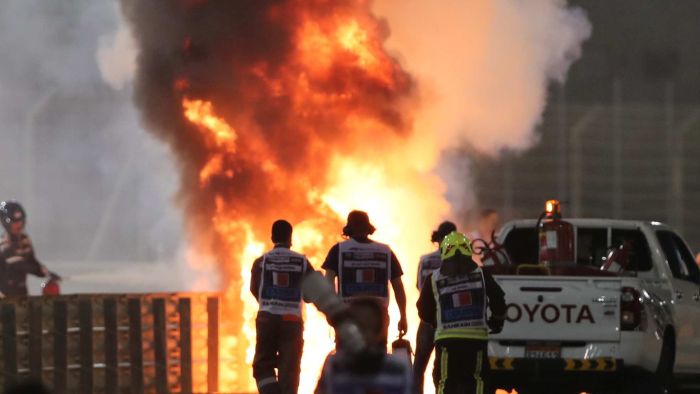The Formula 1 medical car team who helped Romain Grosjean make a “miracle” escape from his fiery Bahrain Grand Prix crash have played down their heroics and said they would learn from it to do better if such a horrific accident happened again.
Key points:
- Doctors who raced to help Grosjean said the fire was like a “furnace”
- One doctor said Grosjean “did a fantastic job of extricating himself” from the burning car
- Ferrari star Sebastian Vettel said he wanted to know how such a dangerous crash occurred
Ian Roberts, a doctor for motorsport governing body FIA, rushed towards the blaze in an open-face helmet to help Grosjean clamber out of the inferno, but said the Frenchman had already done “a fantastic job of extricating himself”.
Grosjean climbed out of the car before the medics could get to him but was helped over the guardrail and away to safety.
Roberts and medical car driver Alan van der Merwe were hailed as heroes after the accident but they said they were just doing their jobs.
“I’m no hero. Lots of people do seriously and proper heroic things. I did what was necessary, so no I don’t consider myself a hero,” the doctor said.
“But I’m very pleased for people’s kind words.”
Van der Merwe said there had already been discussions about changes that could be made for next weekend’s Sakhir Grand Prix at the same circuit.
“Ian and I will do very small things which we think would have bought us some more time or some more margin. We’ve discussed that over breakfast this morning,” he said.
“Now we know what we need to do and what we need to improve on.”
‘I could see him behind a sheet of flame’
Roberts said the scene of the crash had looked like something out of a Hollywood movie when they arrived seconds after Grosjean’s Haas car had speared through the metal barriers, splitting in two and erupting in flames.




“I could see Romain in his car attempting to get out, the fire was well going and I could see him behind essentially a sheet of flame, almost furnace-like,” he said.
A marshal had run across the track with an extinguisher and that was aimed at Grosjean to push the flames back for precious seconds.
As Grosjean appeared at the top of the barrier, Roberts could reach in and grab hold of him.
“I pulled him across over to our car but he couldn’t actually see anything, the tear-offs [strips across the helmet visor] had melted and his visor appeared to be pretty opaque.”




Grosjean, whose last recorded speed before hitting the barrier was 221kph, had burns to the back of his hands but was otherwise unscathed. He is expected to remain in hospital until Tuesday and will not race next weekend.
Van der Merwe said being called a hero was “slightly embarrassing”.
“I think we performed well. I think we can perform better next time,” he said.
“It’s a really positive story, it’s really good for Formula 1. It validates that we’re doing the right thing and that I think we should keep doing what we’re doing, which is to try and improve things.”
The guardrail shouldn’t fail and the car shouldn’t catch fire: Vettel
Grosjean’s fellow drivers are asking questions about how it was allowed to happen at all.
The sport has boosted safety standards massively over the decades, with Grosjean praising his car’s halo head protection device for saving his life, but four-time world champion Sebastian Vettel wants to know how the frightening scene occurred.




“The guardrail is not supposed to fail like that,” the Ferrari star, who like Grosjean is a director of the Grand Prix Drivers’ Association, told Sky Sports.
“It’s good that the cars are safer than they used to be in the past, but the guardrail shouldn’t fail and the car shouldn’t catch fire in that fashion.
The governing FIA said it would launch a complete investigation into the accident, which could take “weeks, if not months”.
It will include a look at why the barrier split and the car caught fire.
“That process will continue,” FIA race director Michael Masi said.
“You learn each and every time, something small, something large. But the process of learning is ongoing.”
Reuters







